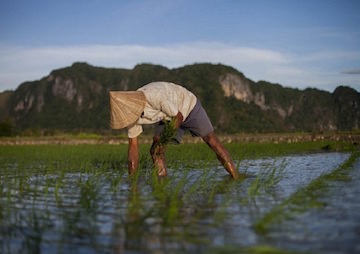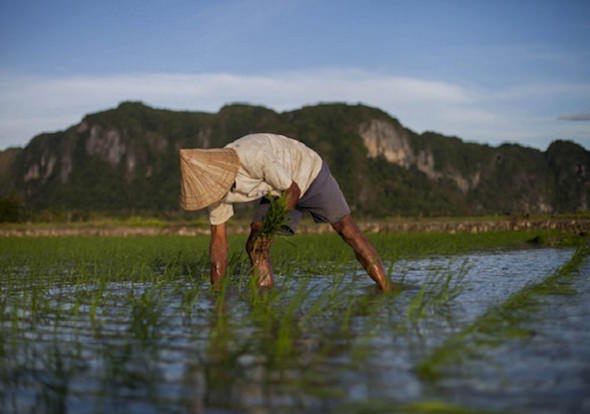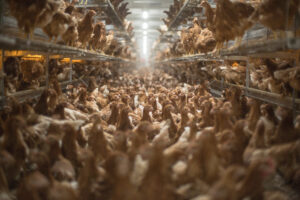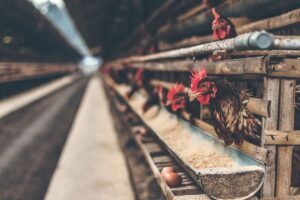Added Gene Can Make Rice More Climate-Friendly
Scientists discover a way to boost production of the grain that billions rely on for food -- and reduce its damaging emissions of methane.
By Tim Radford, Climate News Network

Rice, a staple for billions of people, could soon be more nutritious — and less polluting. (Tri Saputro / CIFOR via Flickr)
This Creative Commons-licensed piece first appeared at Climate News Network.
LONDON — An international team of scientists has found a way to make rice more productive, more nutritious and less of a greenhouse gas producer — simply by adding just one gene from the cereal, barley.
The single gene SUSIBA 2 — the acronym stands for sugar signalling in barley — makes all the difference. And the importance of the breakthrough is that rice feeds half the world — but, as it grows, is one of the great sources of the greenhouse gas, methane.
The world’s rice paddy fields release up to 100 million tonnes each year of methane — possibly 17% of the global total.
And although methane emissions are small compared with carbon dioxide, each molecule of methane is far more potent a global warmer. The gas is 34 times more potent than CO2 over a century, but 84 times more so over a much shorter timespan — just 20 years.
Ideal conditions
The conditions ideal for rice — warm and waterlogged, and mud, rich with nutrients — are also ideal for the generation of methane.
The scientists from China, Sweden and the US report in Nature journal that they calculated that if they could do something to encourage the conversion of sugars to starches in the rice plant, there would be more productivity in the stalk and ears, and less around the roots, where the methane-generating bacteria flourish.
In their words, this would “generate a high starch, low methane emission variety”.
They used transcription factor technology — a form of genetic modification that could soon also deliver better drought tolerance in some important crop plants – and began tests at the Fujian Academy of Agricultural Sciences in Fuzhou, China, in 2012 and 2013. Transcription factors bind to genes and turn them on or off.
“As the world’s population grows, so will rice production. And as the Earth warms, so will rice paddies, resulting in even more methane emissions.”
Earlier experiments in Sweden had helped the team understand how to manage the transcription factors so they could just about dictate which parts of the plant absorbed more of the carbon taken from the atmosphere by photosynthesis.
The result was a rice variety that yielded more starch, so that it delivered more energy per spoonful for a hungry household, or that could be converted to more biofuel during times of surplus.
Japanese scientists, too, have been looking for ways to get all the value they can out of one of the world’s most vital crops. But the other important outcome, the researchers say, was a near-elimination of methane production from around the roots.
The next step is to look at what happens in the paddy fields, and try to understand what is going on and what the change could mean for methane-generating bacteria.
Test variety
The scientists also dried the whole plant once it had ripened to examine what had occurred, and to compare it with control varieties in the same fields. They found that grains of the test variety contained almost 87% starch, compared with 77% in the control sample.
The research still has a long way to go, but given that global population could sometime this century hit or even surpass 10 billion, and given that the land available for farming cannot expand, there is pressure to increase yields per field.
Ominously, research so far suggests that global warming — and the accompanying greater extremes of heat in the growing season — could reduce yields. So plant scientists must make the most of any advances in the understanding of the biology of growth.
“The need to increase starch content and to lower methane emissions from rice production is widely recognised, but the ability to do both simultaneously has eluded researchers,” says Christer Jansson, a co-author of the report, and director of plant sciences at the US Pacific Northwest National Laboratory.
“As the world’s population grows, so will rice production. And as the Earth warms, so will rice paddies, resulting in even more methane emissions. It’s an issue that must be addressed.”
Your support is crucial...As we navigate an uncertain 2025, with a new administration questioning press freedoms, the risks are clear: our ability to report freely is under threat.
Your tax-deductible donation enables us to dig deeper, delivering fearless investigative reporting and analysis that exposes the reality beneath the headlines — without compromise.
Now is the time to take action. Stand with our courageous journalists. Donate today to protect a free press, uphold democracy and uncover the stories that need to be told.







You need to be a supporter to comment.
There are currently no responses to this article.
Be the first to respond.